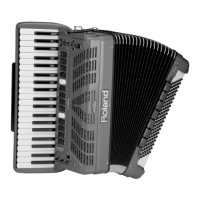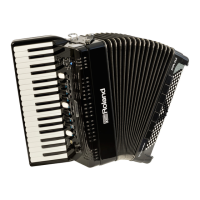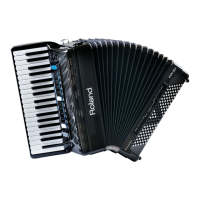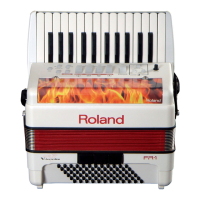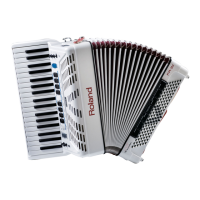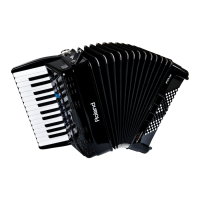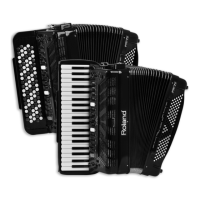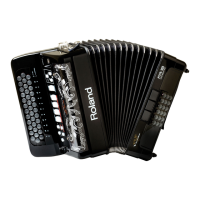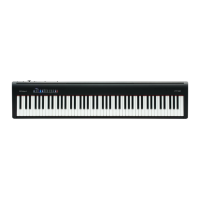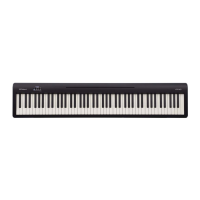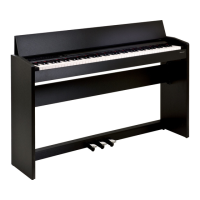Selecting Parameters
77
Parameter Value Explanation
Volume
O, 0~127
Default: 100
See “2.7 MIDI TX” (p. 73) for
details.
Panpot
O, 0~127
Default: 64
See “2.7 MIDI TX” (p. 73) for
details.
Reverb
O, 0~127
Default: 40
See “2.7 MIDI TX” (p. 73) for
details.
Chorus
O, 0~127
Default: 0
See “2.7 MIDI TX” (p. 73) for
details.
Velocity
On, 1~127
Default: On
See “2.7 MIDI TX” (p. 73) for
details.
Expression
O, Bellows, Pedal
Default: Belows
See “2.7 MIDI TX” (p. 73) for
details.
Aftertouch
O, On
Default: On
See “2.7 MIDI TX” (p. 73) for
details.
Sustain
O, On
Default: On
See “2.7 MIDI TX” (p. 73) for
details..
3.8 Name
This parameter allows you to name the currently
selected bass register for easy reference while
performing with the FR-8x.
The FR-8x suggests the name of selected register.
1. Use the [DATA/ENTER] knob to enter the desired name.
See “How to type a name in FR-8x” (p. 31).
2. Press [EXIT/JUMP] button to exit from the selection.
4. Free Bass Edit parameters
The parameters of the “Free Bass Edit” group apply to the bass
section when it is used in Free Bass mode. See “Free Bass System
(F.BASS)” (p. 35). They can be saved to the selected Set.
See “Selecting Parameters” (p. 68) for how to select and adjust
the parameters.
Press [UP] and [DOWN] simultaneously to select the value that is
indicated as “Default setting”.
NOTE
These parameters can only be selected if the Free Bass section is
activated ([FBASS] button indicator lights).
Introduction to Bass Parameters
All changes you make here apply to the last Free Bass register you
selected. So be sure to select LEFT HAND [F.BASS] button and press
the register whose settings you wish to change before selecting
and editing any of the Free Bass Edit parameters. You can, however,
decide to save your settings to a dierent register if you realize that
you’ve been editing the wrong one..
IMPORTANT NOTE
The FR-8x internal memory remembers your settings while the
FR-8x is switched on. While editing, there is no absolute need
to save your settings. Be aware, however, that all changes are
lost when the FR-8x is switched o.
See “How to Save a Set” (p. 42) to save your changes. Also
be sure to read “Important remark about saving your settings”
(p. 70).
4.1 Reed Type
Thee parameters allow you to transform the
selected register into a dierent instrument, and to
assign dierent sounds to each reed the register
plays.
Bear in mind, however, that the parameters on this
page apply to the selected Free Bass register.
Parameter Value Explanation
FOOT All, 16’, 8’
Chose the reed you wish to assign
another sound to.
NOTE
Whenever you select “All” and
set a dierent reed type, the
“VALVE NOISE” setting ( p. 72)
is automatically adapted to the
reed type you select here. You
may have to change it afterwards
if you wish to use a dierent noise
type.
TYPE
Bandoneon, I-Folk,
I-Folk2, Classic,
Cajun, Jazz, F-Folk,
D-Folk, Organetto,
F-Folk2, Classic2,
Studio, Tradition,
Steierische, Trikitixa,
F-Jazz, Classic3,
Bajan
Select a type of instrument.
REED GROWL
Bandoneon, I-Folk,
I-Folk2, Classic,
Cajun, Jazz, F-Folk,
D-Folk, Organetto,
F-Folk2, Classic2,
Studio, Tradition,
Steierische, Trikitixa,
F-Jazz, Classic3,
Bajan
This parameter allows you to
simulate the typical noise a bass reed
makes just before it stops vibrating
altogether.
Each instrument of the accordion
family produces its own typical
growl. The growl that matches the
sound selected with “4.1 Reed Type”
probably yields the most realistic
eect, but feel free to select another
one if you like it better.
LEVEL O, –40~Std~40
This is the last parameter that can be
set for each reed individually.
It allows you to create the desired
“mix” (volume balance) for the active
reeds.
This is a relative parameter: its value
is added to or subtracted from the
standard value (“Std”). As a rule, rst
decide which reed is most important
and set its “Volume” parameter to
“Std”. Then reduce or increase the
volume of the “ancillary” reeds to
create the desired balance.
4.2 Register
The parameters on this page are used in
combination with the parameters above. Here, you
decide which reeds should be audible and how
they should be played. It is therefore on this page
that you specify whether the sounds you selected
above will be used.
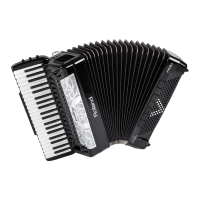
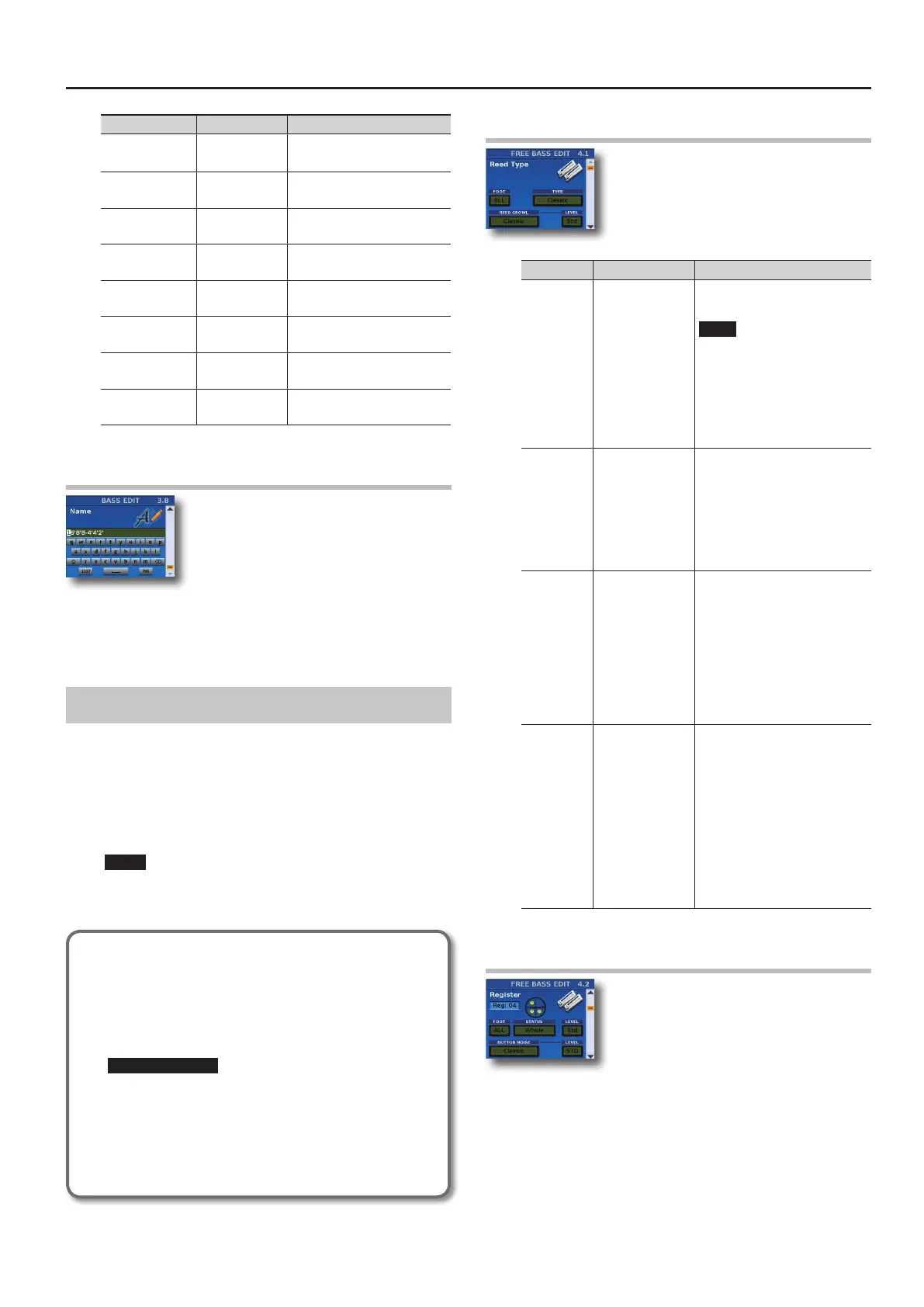